Nursing Research Report: Adolescent Smoking, Causes, and Interventions
VerifiedAdded on 2020/02/24
|23
|5216
|68
Report
AI Summary
This nursing research paper investigates the reduction of smoking habits in 12-15 year-old children. The introduction defines smoking, its harmful effects, and the common reasons teenagers start smoking, including peer influence and stress. The research question focuses on educating adolescents to quit smoking. The literature review highlights the prevalence of adolescent smoking in Australia, the health risks associated with tobacco use, and the legal status of tobacco products. The methodology involves a cross-sectional study using the Global Youth Tobacco Survey (GYTS) questionnaire, with data collected from secondary and high school students. The data analysis includes background information, tobacco use patterns, attitudes towards smoking, and methods of obtaining cigarettes. The paper explores clinical strategies, ethical considerations, and the strengths and weaknesses of the study, concluding with recommendations for intervention and prevention of smoking habits in adolescents. The research highlights the need for educational campaigns and support systems to help young people quit smoking and avoid the health risks associated with tobacco use.
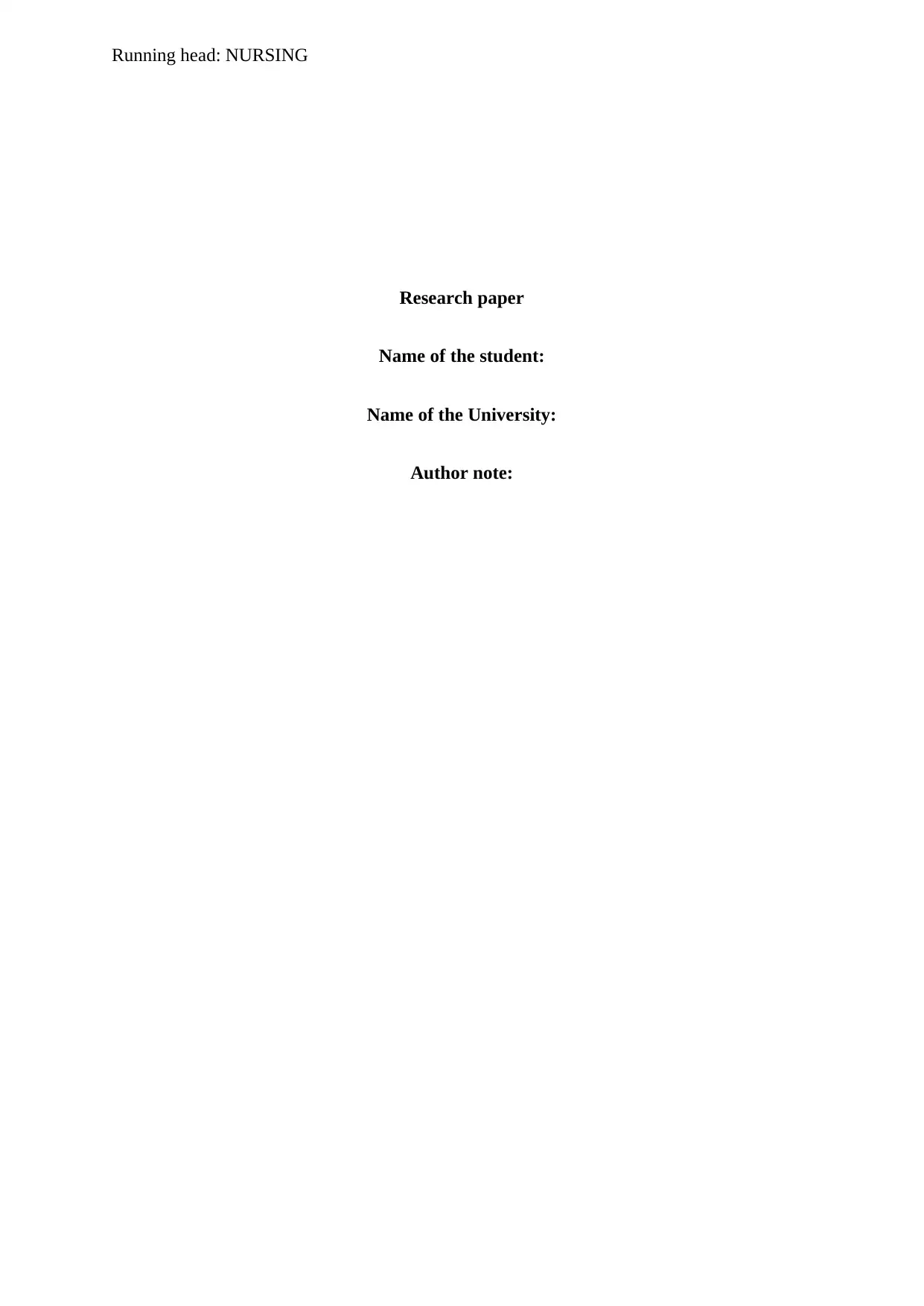
Running head: NURSING
Research paper
Name of the student:
Name of the University:
Author note:
Research paper
Name of the student:
Name of the University:
Author note:
Paraphrase This Document
Need a fresh take? Get an instant paraphrase of this document with our AI Paraphraser
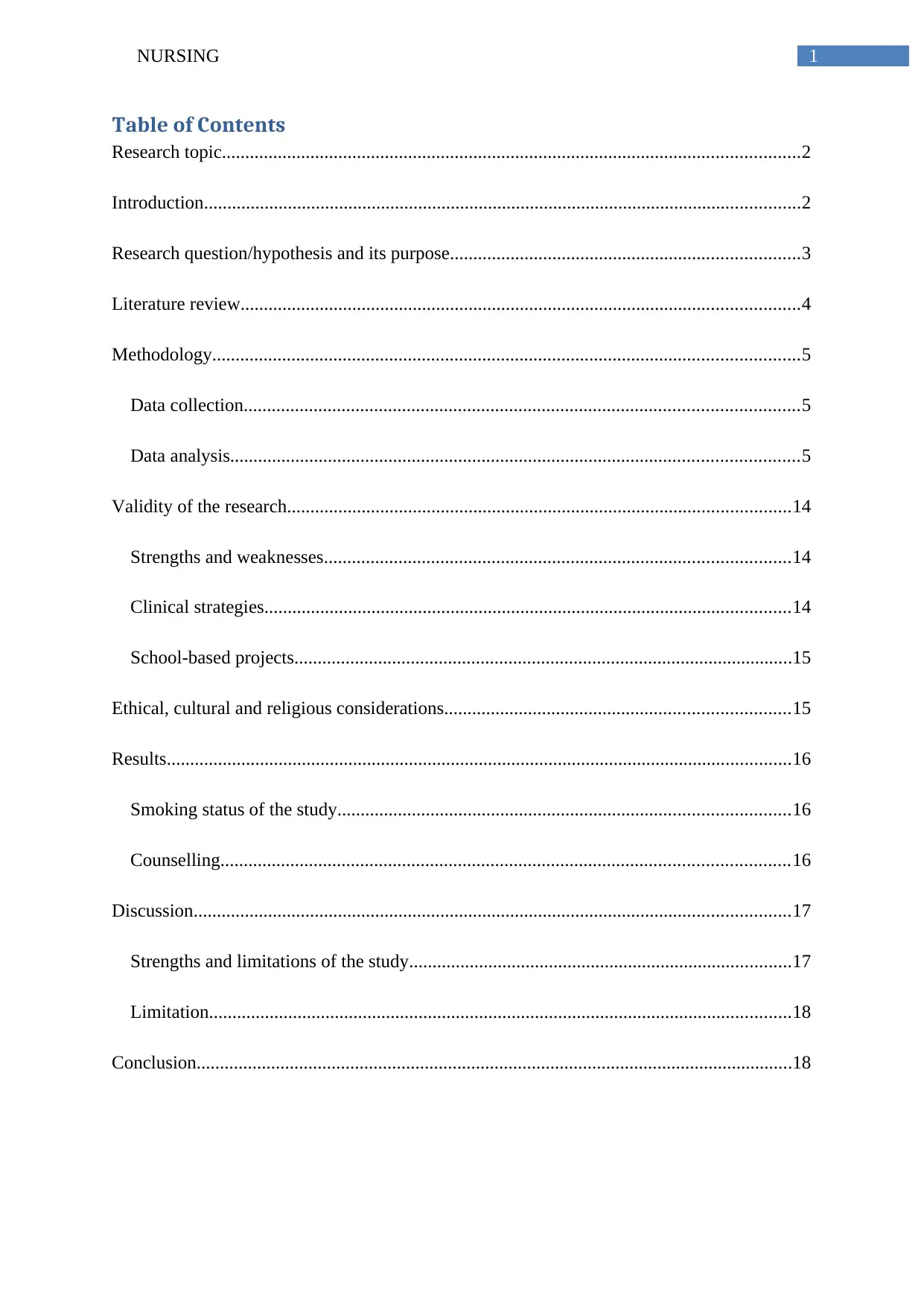
1NURSING
Table of Contents
Research topic............................................................................................................................2
Introduction................................................................................................................................2
Research question/hypothesis and its purpose...........................................................................3
Literature review........................................................................................................................4
Methodology..............................................................................................................................5
Data collection.......................................................................................................................5
Data analysis..........................................................................................................................5
Validity of the research............................................................................................................14
Strengths and weaknesses....................................................................................................14
Clinical strategies.................................................................................................................14
School-based projects...........................................................................................................15
Ethical, cultural and religious considerations..........................................................................15
Results......................................................................................................................................16
Smoking status of the study.................................................................................................16
Counselling..........................................................................................................................16
Discussion................................................................................................................................17
Strengths and limitations of the study..................................................................................17
Limitation.............................................................................................................................18
Conclusion................................................................................................................................18
Table of Contents
Research topic............................................................................................................................2
Introduction................................................................................................................................2
Research question/hypothesis and its purpose...........................................................................3
Literature review........................................................................................................................4
Methodology..............................................................................................................................5
Data collection.......................................................................................................................5
Data analysis..........................................................................................................................5
Validity of the research............................................................................................................14
Strengths and weaknesses....................................................................................................14
Clinical strategies.................................................................................................................14
School-based projects...........................................................................................................15
Ethical, cultural and religious considerations..........................................................................15
Results......................................................................................................................................16
Smoking status of the study.................................................................................................16
Counselling..........................................................................................................................16
Discussion................................................................................................................................17
Strengths and limitations of the study..................................................................................17
Limitation.............................................................................................................................18
Conclusion................................................................................................................................18
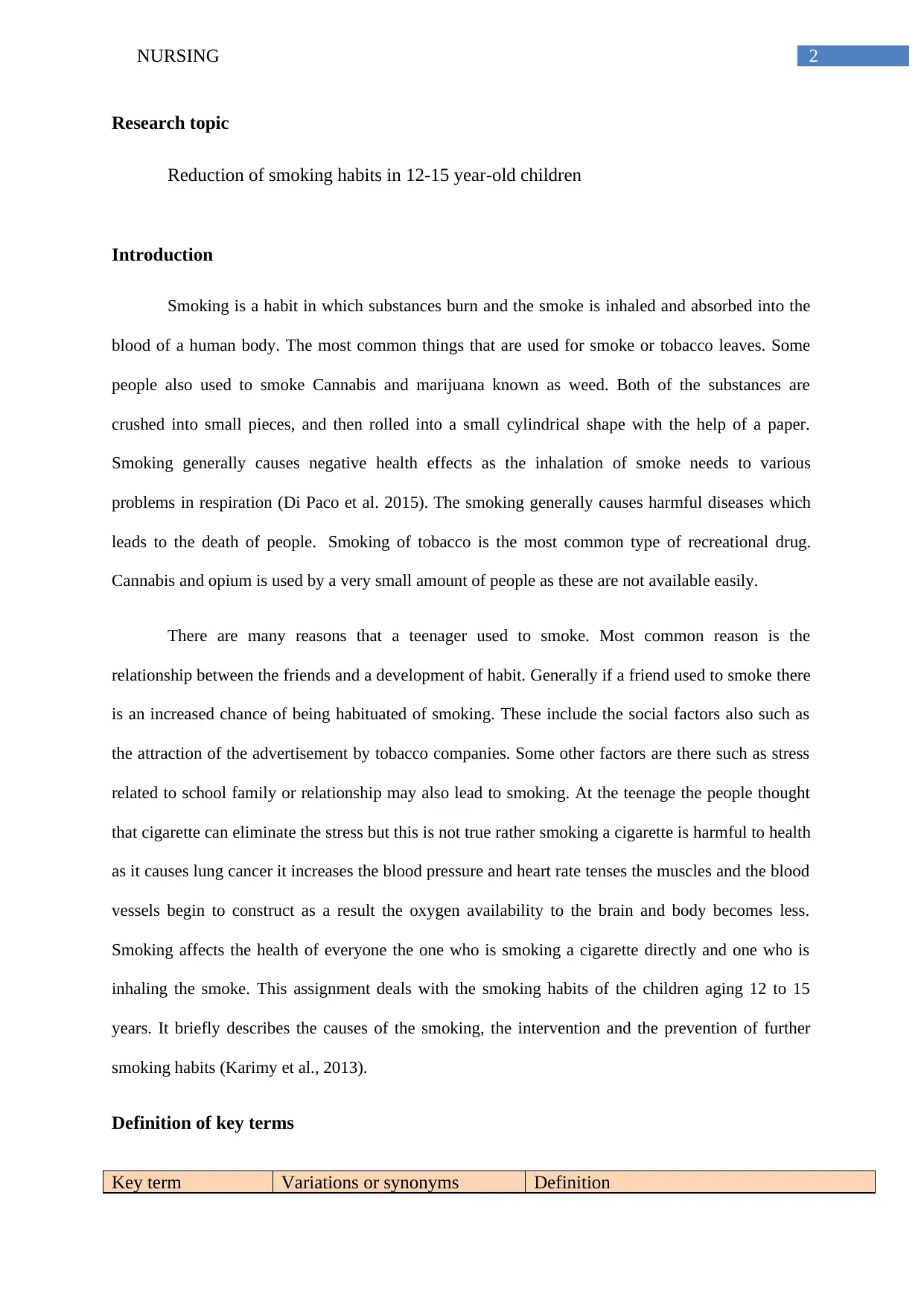
2NURSING
Research topic
Reduction of smoking habits in 12-15 year-old children
Introduction
Smoking is a habit in which substances burn and the smoke is inhaled and absorbed into the
blood of a human body. The most common things that are used for smoke or tobacco leaves. Some
people also used to smoke Cannabis and marijuana known as weed. Both of the substances are
crushed into small pieces, and then rolled into a small cylindrical shape with the help of a paper.
Smoking generally causes negative health effects as the inhalation of smoke needs to various
problems in respiration (Di Paco et al. 2015). The smoking generally causes harmful diseases which
leads to the death of people. Smoking of tobacco is the most common type of recreational drug.
Cannabis and opium is used by a very small amount of people as these are not available easily.
There are many reasons that a teenager used to smoke. Most common reason is the
relationship between the friends and a development of habit. Generally if a friend used to smoke there
is an increased chance of being habituated of smoking. These include the social factors also such as
the attraction of the advertisement by tobacco companies. Some other factors are there such as stress
related to school family or relationship may also lead to smoking. At the teenage the people thought
that cigarette can eliminate the stress but this is not true rather smoking a cigarette is harmful to health
as it causes lung cancer it increases the blood pressure and heart rate tenses the muscles and the blood
vessels begin to construct as a result the oxygen availability to the brain and body becomes less.
Smoking affects the health of everyone the one who is smoking a cigarette directly and one who is
inhaling the smoke. This assignment deals with the smoking habits of the children aging 12 to 15
years. It briefly describes the causes of the smoking, the intervention and the prevention of further
smoking habits (Karimy et al., 2013).
Definition of key terms
Key term Variations or synonyms Definition
Research topic
Reduction of smoking habits in 12-15 year-old children
Introduction
Smoking is a habit in which substances burn and the smoke is inhaled and absorbed into the
blood of a human body. The most common things that are used for smoke or tobacco leaves. Some
people also used to smoke Cannabis and marijuana known as weed. Both of the substances are
crushed into small pieces, and then rolled into a small cylindrical shape with the help of a paper.
Smoking generally causes negative health effects as the inhalation of smoke needs to various
problems in respiration (Di Paco et al. 2015). The smoking generally causes harmful diseases which
leads to the death of people. Smoking of tobacco is the most common type of recreational drug.
Cannabis and opium is used by a very small amount of people as these are not available easily.
There are many reasons that a teenager used to smoke. Most common reason is the
relationship between the friends and a development of habit. Generally if a friend used to smoke there
is an increased chance of being habituated of smoking. These include the social factors also such as
the attraction of the advertisement by tobacco companies. Some other factors are there such as stress
related to school family or relationship may also lead to smoking. At the teenage the people thought
that cigarette can eliminate the stress but this is not true rather smoking a cigarette is harmful to health
as it causes lung cancer it increases the blood pressure and heart rate tenses the muscles and the blood
vessels begin to construct as a result the oxygen availability to the brain and body becomes less.
Smoking affects the health of everyone the one who is smoking a cigarette directly and one who is
inhaling the smoke. This assignment deals with the smoking habits of the children aging 12 to 15
years. It briefly describes the causes of the smoking, the intervention and the prevention of further
smoking habits (Karimy et al., 2013).
Definition of key terms
Key term Variations or synonyms Definition
⊘ This is a preview!⊘
Do you want full access?
Subscribe today to unlock all pages.

Trusted by 1+ million students worldwide
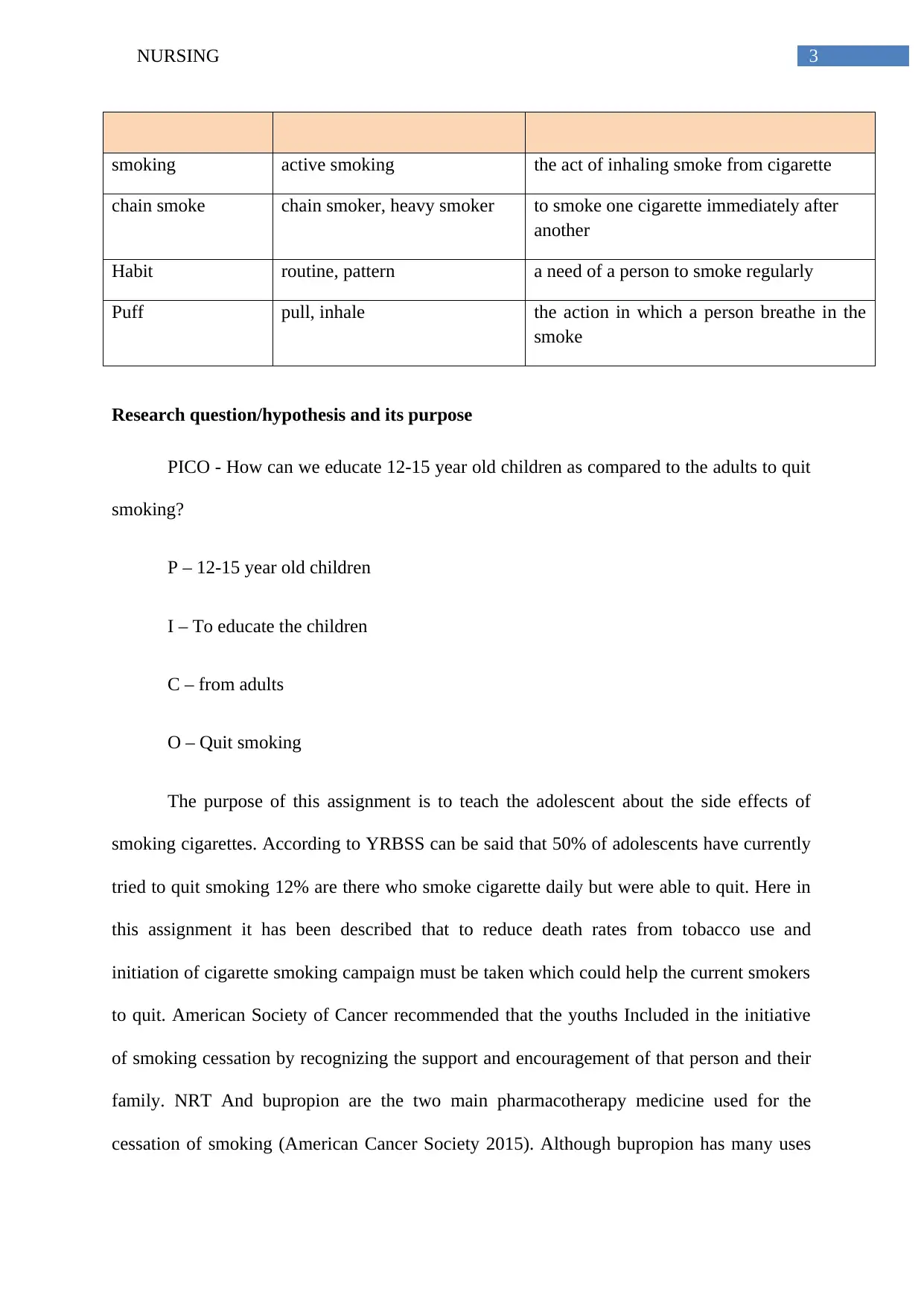
3NURSING
smoking active smoking the act of inhaling smoke from cigarette
chain smoke chain smoker, heavy smoker to smoke one cigarette immediately after
another
Habit routine, pattern a need of a person to smoke regularly
Puff pull, inhale the action in which a person breathe in the
smoke
Research question/hypothesis and its purpose
PICO - How can we educate 12-15 year old children as compared to the adults to quit
smoking?
P – 12-15 year old children
I – To educate the children
C – from adults
O – Quit smoking
The purpose of this assignment is to teach the adolescent about the side effects of
smoking cigarettes. According to YRBSS can be said that 50% of adolescents have currently
tried to quit smoking 12% are there who smoke cigarette daily but were able to quit. Here in
this assignment it has been described that to reduce death rates from tobacco use and
initiation of cigarette smoking campaign must be taken which could help the current smokers
to quit. American Society of Cancer recommended that the youths Included in the initiative
of smoking cessation by recognizing the support and encouragement of that person and their
family. NRT And bupropion are the two main pharmacotherapy medicine used for the
cessation of smoking (American Cancer Society 2015). Although bupropion has many uses
smoking active smoking the act of inhaling smoke from cigarette
chain smoke chain smoker, heavy smoker to smoke one cigarette immediately after
another
Habit routine, pattern a need of a person to smoke regularly
Puff pull, inhale the action in which a person breathe in the
smoke
Research question/hypothesis and its purpose
PICO - How can we educate 12-15 year old children as compared to the adults to quit
smoking?
P – 12-15 year old children
I – To educate the children
C – from adults
O – Quit smoking
The purpose of this assignment is to teach the adolescent about the side effects of
smoking cigarettes. According to YRBSS can be said that 50% of adolescents have currently
tried to quit smoking 12% are there who smoke cigarette daily but were able to quit. Here in
this assignment it has been described that to reduce death rates from tobacco use and
initiation of cigarette smoking campaign must be taken which could help the current smokers
to quit. American Society of Cancer recommended that the youths Included in the initiative
of smoking cessation by recognizing the support and encouragement of that person and their
family. NRT And bupropion are the two main pharmacotherapy medicine used for the
cessation of smoking (American Cancer Society 2015). Although bupropion has many uses
Paraphrase This Document
Need a fresh take? Get an instant paraphrase of this document with our AI Paraphraser
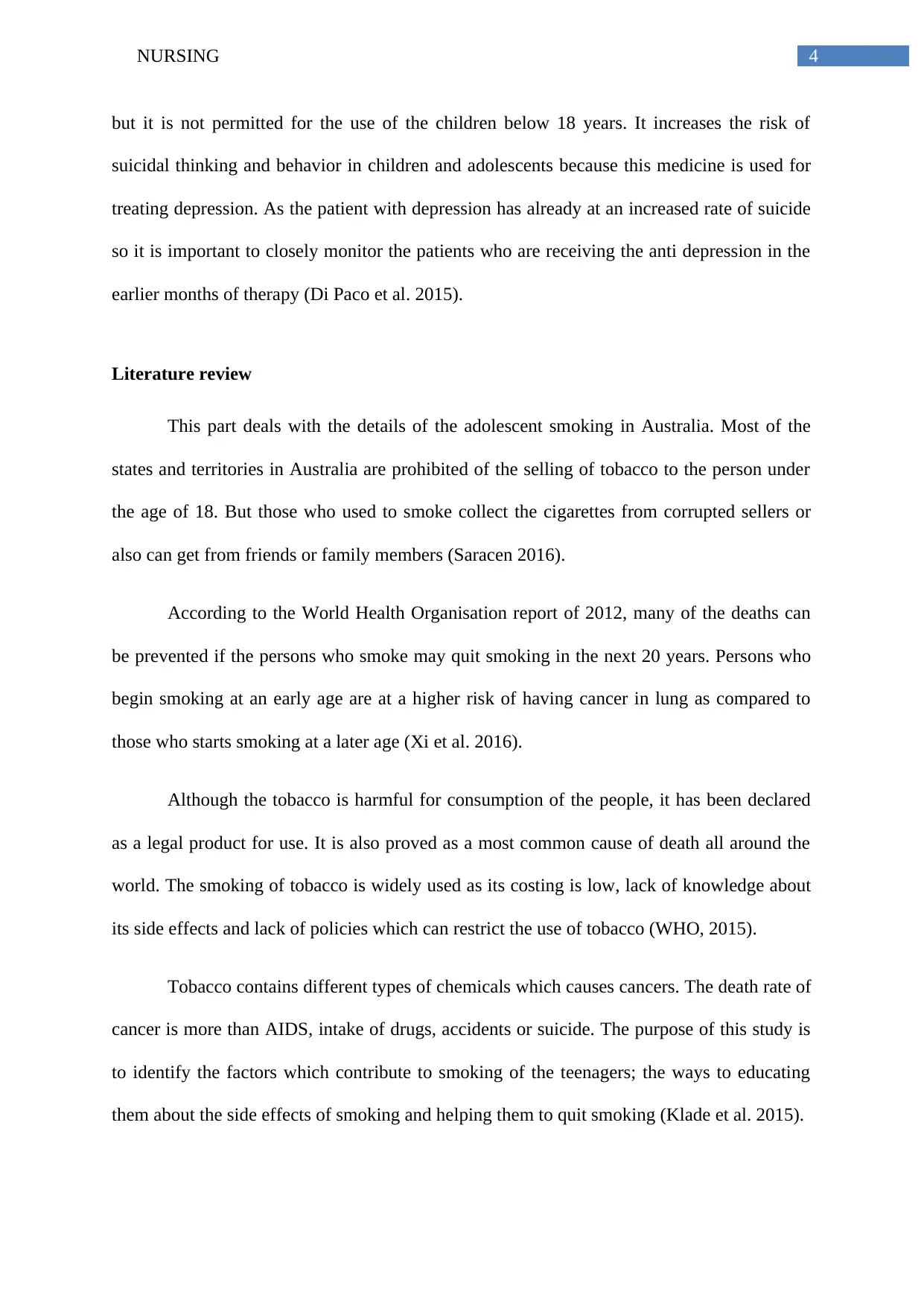
4NURSING
but it is not permitted for the use of the children below 18 years. It increases the risk of
suicidal thinking and behavior in children and adolescents because this medicine is used for
treating depression. As the patient with depression has already at an increased rate of suicide
so it is important to closely monitor the patients who are receiving the anti depression in the
earlier months of therapy (Di Paco et al. 2015).
Literature review
This part deals with the details of the adolescent smoking in Australia. Most of the
states and territories in Australia are prohibited of the selling of tobacco to the person under
the age of 18. But those who used to smoke collect the cigarettes from corrupted sellers or
also can get from friends or family members (Saracen 2016).
According to the World Health Organisation report of 2012, many of the deaths can
be prevented if the persons who smoke may quit smoking in the next 20 years. Persons who
begin smoking at an early age are at a higher risk of having cancer in lung as compared to
those who starts smoking at a later age (Xi et al. 2016).
Although the tobacco is harmful for consumption of the people, it has been declared
as a legal product for use. It is also proved as a most common cause of death all around the
world. The smoking of tobacco is widely used as its costing is low, lack of knowledge about
its side effects and lack of policies which can restrict the use of tobacco (WHO, 2015).
Tobacco contains different types of chemicals which causes cancers. The death rate of
cancer is more than AIDS, intake of drugs, accidents or suicide. The purpose of this study is
to identify the factors which contribute to smoking of the teenagers; the ways to educating
them about the side effects of smoking and helping them to quit smoking (Klade et al. 2015).
but it is not permitted for the use of the children below 18 years. It increases the risk of
suicidal thinking and behavior in children and adolescents because this medicine is used for
treating depression. As the patient with depression has already at an increased rate of suicide
so it is important to closely monitor the patients who are receiving the anti depression in the
earlier months of therapy (Di Paco et al. 2015).
Literature review
This part deals with the details of the adolescent smoking in Australia. Most of the
states and territories in Australia are prohibited of the selling of tobacco to the person under
the age of 18. But those who used to smoke collect the cigarettes from corrupted sellers or
also can get from friends or family members (Saracen 2016).
According to the World Health Organisation report of 2012, many of the deaths can
be prevented if the persons who smoke may quit smoking in the next 20 years. Persons who
begin smoking at an early age are at a higher risk of having cancer in lung as compared to
those who starts smoking at a later age (Xi et al. 2016).
Although the tobacco is harmful for consumption of the people, it has been declared
as a legal product for use. It is also proved as a most common cause of death all around the
world. The smoking of tobacco is widely used as its costing is low, lack of knowledge about
its side effects and lack of policies which can restrict the use of tobacco (WHO, 2015).
Tobacco contains different types of chemicals which causes cancers. The death rate of
cancer is more than AIDS, intake of drugs, accidents or suicide. The purpose of this study is
to identify the factors which contribute to smoking of the teenagers; the ways to educating
them about the side effects of smoking and helping them to quit smoking (Klade et al. 2015).
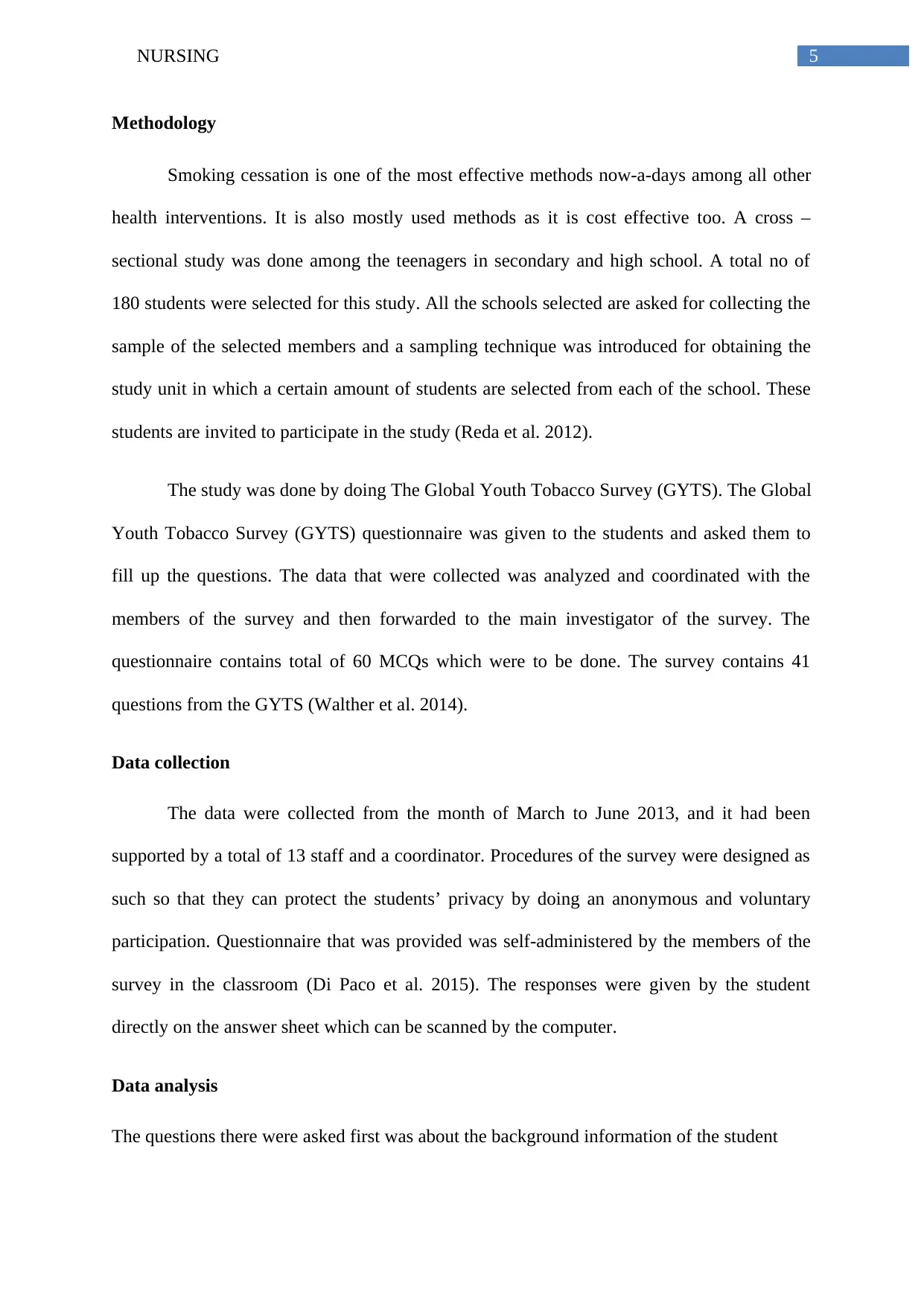
5NURSING
Methodology
Smoking cessation is one of the most effective methods now-a-days among all other
health interventions. It is also mostly used methods as it is cost effective too. A cross –
sectional study was done among the teenagers in secondary and high school. A total no of
180 students were selected for this study. All the schools selected are asked for collecting the
sample of the selected members and a sampling technique was introduced for obtaining the
study unit in which a certain amount of students are selected from each of the school. These
students are invited to participate in the study (Reda et al. 2012).
The study was done by doing The Global Youth Tobacco Survey (GYTS). The Global
Youth Tobacco Survey (GYTS) questionnaire was given to the students and asked them to
fill up the questions. The data that were collected was analyzed and coordinated with the
members of the survey and then forwarded to the main investigator of the survey. The
questionnaire contains total of 60 MCQs which were to be done. The survey contains 41
questions from the GYTS (Walther et al. 2014).
Data collection
The data were collected from the month of March to June 2013, and it had been
supported by a total of 13 staff and a coordinator. Procedures of the survey were designed as
such so that they can protect the students’ privacy by doing an anonymous and voluntary
participation. Questionnaire that was provided was self-administered by the members of the
survey in the classroom (Di Paco et al. 2015). The responses were given by the student
directly on the answer sheet which can be scanned by the computer.
Data analysis
The questions there were asked first was about the background information of the student
Methodology
Smoking cessation is one of the most effective methods now-a-days among all other
health interventions. It is also mostly used methods as it is cost effective too. A cross –
sectional study was done among the teenagers in secondary and high school. A total no of
180 students were selected for this study. All the schools selected are asked for collecting the
sample of the selected members and a sampling technique was introduced for obtaining the
study unit in which a certain amount of students are selected from each of the school. These
students are invited to participate in the study (Reda et al. 2012).
The study was done by doing The Global Youth Tobacco Survey (GYTS). The Global
Youth Tobacco Survey (GYTS) questionnaire was given to the students and asked them to
fill up the questions. The data that were collected was analyzed and coordinated with the
members of the survey and then forwarded to the main investigator of the survey. The
questionnaire contains total of 60 MCQs which were to be done. The survey contains 41
questions from the GYTS (Walther et al. 2014).
Data collection
The data were collected from the month of March to June 2013, and it had been
supported by a total of 13 staff and a coordinator. Procedures of the survey were designed as
such so that they can protect the students’ privacy by doing an anonymous and voluntary
participation. Questionnaire that was provided was self-administered by the members of the
survey in the classroom (Di Paco et al. 2015). The responses were given by the student
directly on the answer sheet which can be scanned by the computer.
Data analysis
The questions there were asked first was about the background information of the student
⊘ This is a preview!⊘
Do you want full access?
Subscribe today to unlock all pages.

Trusted by 1+ million students worldwide
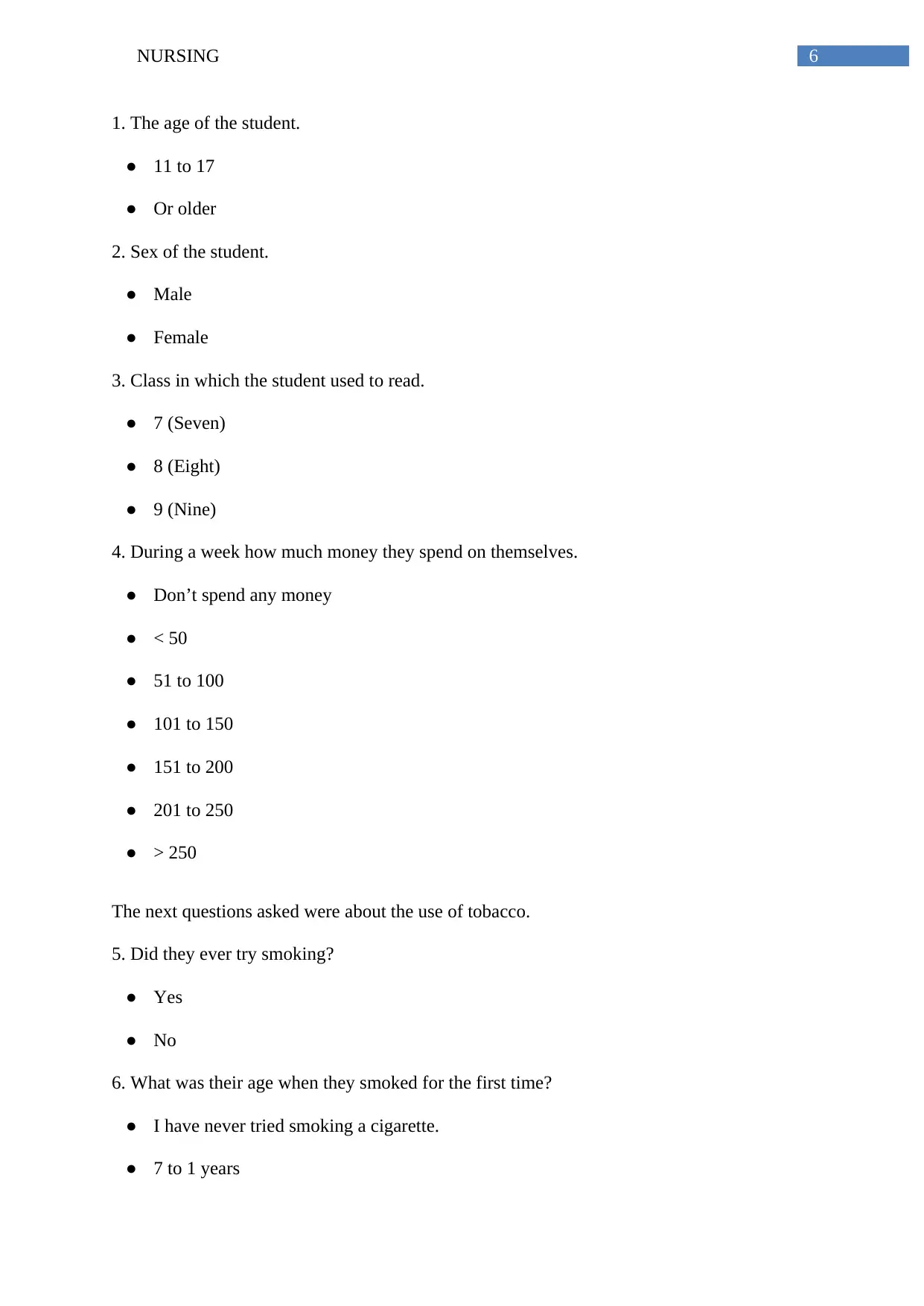
6NURSING
1. The age of the student.
● 11 to 17
● Or older
2. Sex of the student.
● Male
● Female
3. Class in which the student used to read.
● 7 (Seven)
● 8 (Eight)
● 9 (Nine)
4. During a week how much money they spend on themselves.
● Don’t spend any money
● < 50
● 51 to 100
● 101 to 150
● 151 to 200
● 201 to 250
● > 250
The next questions asked were about the use of tobacco.
5. Did they ever try smoking?
● Yes
● No
6. What was their age when they smoked for the first time?
● I have never tried smoking a cigarette.
● 7 to 1 years
1. The age of the student.
● 11 to 17
● Or older
2. Sex of the student.
● Male
● Female
3. Class in which the student used to read.
● 7 (Seven)
● 8 (Eight)
● 9 (Nine)
4. During a week how much money they spend on themselves.
● Don’t spend any money
● < 50
● 51 to 100
● 101 to 150
● 151 to 200
● 201 to 250
● > 250
The next questions asked were about the use of tobacco.
5. Did they ever try smoking?
● Yes
● No
6. What was their age when they smoked for the first time?
● I have never tried smoking a cigarette.
● 7 to 1 years
Paraphrase This Document
Need a fresh take? Get an instant paraphrase of this document with our AI Paraphraser
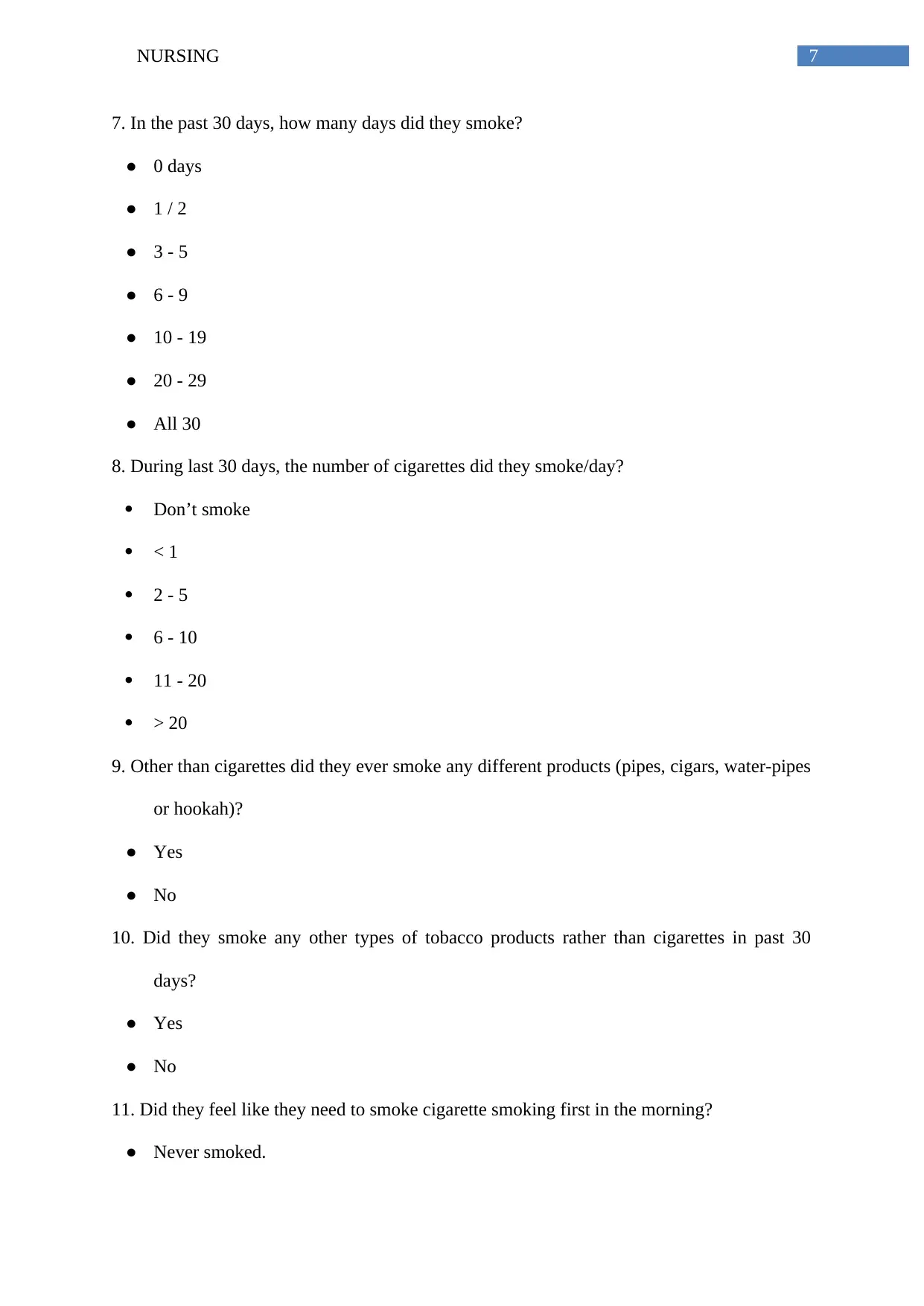
7NURSING
7. In the past 30 days, how many days did they smoke?
● 0 days
● 1 / 2
● 3 - 5
● 6 - 9
● 10 - 19
● 20 - 29
● All 30
8. During last 30 days, the number of cigarettes did they smoke/day?
Don’t smoke
< 1
2 - 5
6 - 10
11 - 20
> 20
9. Other than cigarettes did they ever smoke any different products (pipes, cigars, water-pipes
or hookah)?
● Yes
● No
10. Did they smoke any other types of tobacco products rather than cigarettes in past 30
days?
● Yes
● No
11. Did they feel like they need to smoke cigarette smoking first in the morning?
● Never smoked.
7. In the past 30 days, how many days did they smoke?
● 0 days
● 1 / 2
● 3 - 5
● 6 - 9
● 10 - 19
● 20 - 29
● All 30
8. During last 30 days, the number of cigarettes did they smoke/day?
Don’t smoke
< 1
2 - 5
6 - 10
11 - 20
> 20
9. Other than cigarettes did they ever smoke any different products (pipes, cigars, water-pipes
or hookah)?
● Yes
● No
10. Did they smoke any other types of tobacco products rather than cigarettes in past 30
days?
● Yes
● No
11. Did they feel like they need to smoke cigarette smoking first in the morning?
● Never smoked.
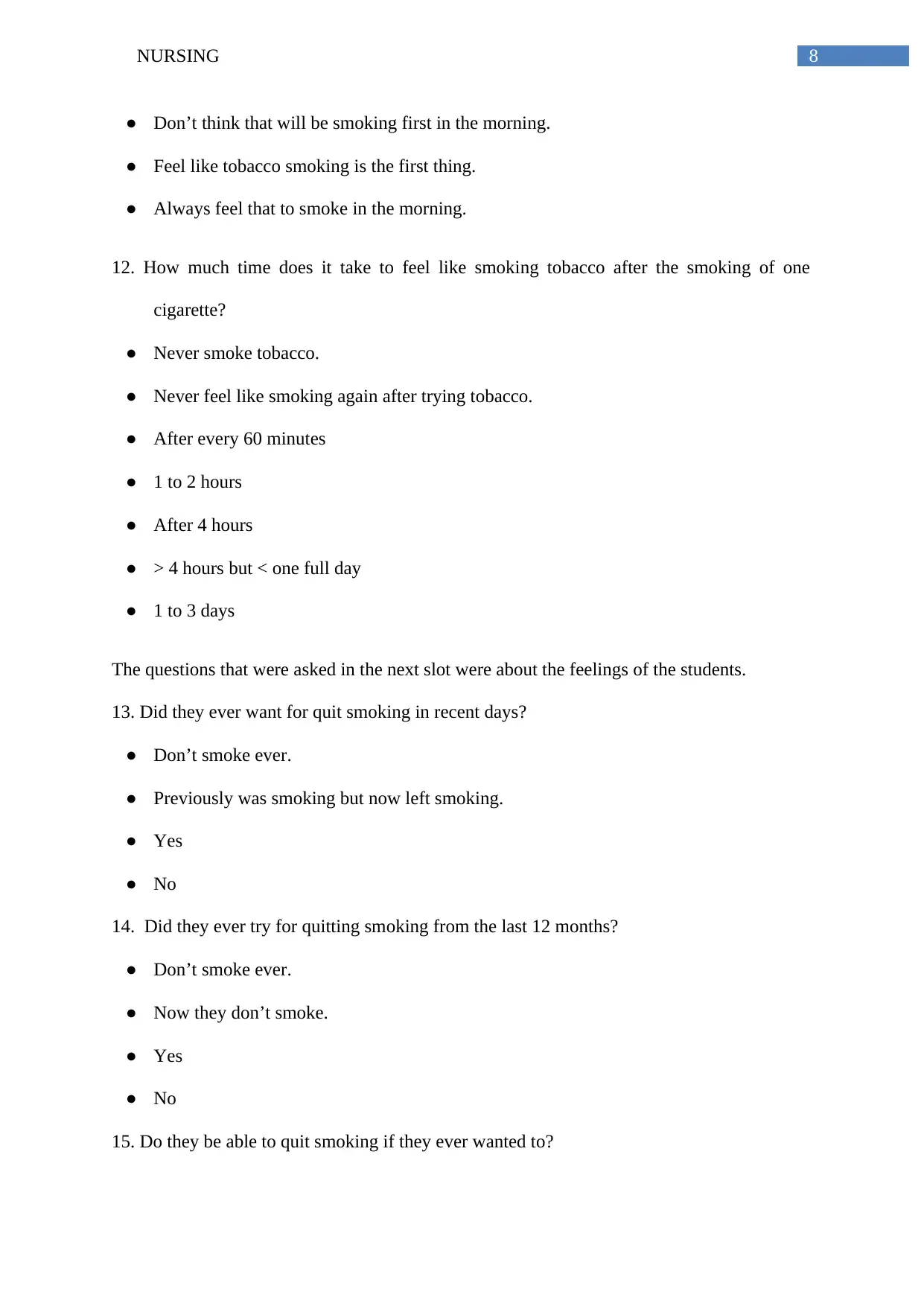
8NURSING
● Don’t think that will be smoking first in the morning.
● Feel like tobacco smoking is the first thing.
● Always feel that to smoke in the morning.
12. How much time does it take to feel like smoking tobacco after the smoking of one
cigarette?
● Never smoke tobacco.
● Never feel like smoking again after trying tobacco.
● After every 60 minutes
● 1 to 2 hours
● After 4 hours
● > 4 hours but < one full day
● 1 to 3 days
The questions that were asked in the next slot were about the feelings of the students.
13. Did they ever want for quit smoking in recent days?
● Don’t smoke ever.
● Previously was smoking but now left smoking.
● Yes
● No
14. Did they ever try for quitting smoking from the last 12 months?
● Don’t smoke ever.
● Now they don’t smoke.
● Yes
● No
15. Do they be able to quit smoking if they ever wanted to?
● Don’t think that will be smoking first in the morning.
● Feel like tobacco smoking is the first thing.
● Always feel that to smoke in the morning.
12. How much time does it take to feel like smoking tobacco after the smoking of one
cigarette?
● Never smoke tobacco.
● Never feel like smoking again after trying tobacco.
● After every 60 minutes
● 1 to 2 hours
● After 4 hours
● > 4 hours but < one full day
● 1 to 3 days
The questions that were asked in the next slot were about the feelings of the students.
13. Did they ever want for quit smoking in recent days?
● Don’t smoke ever.
● Previously was smoking but now left smoking.
● Yes
● No
14. Did they ever try for quitting smoking from the last 12 months?
● Don’t smoke ever.
● Now they don’t smoke.
● Yes
● No
15. Do they be able to quit smoking if they ever wanted to?
⊘ This is a preview!⊘
Do you want full access?
Subscribe today to unlock all pages.

Trusted by 1+ million students worldwide
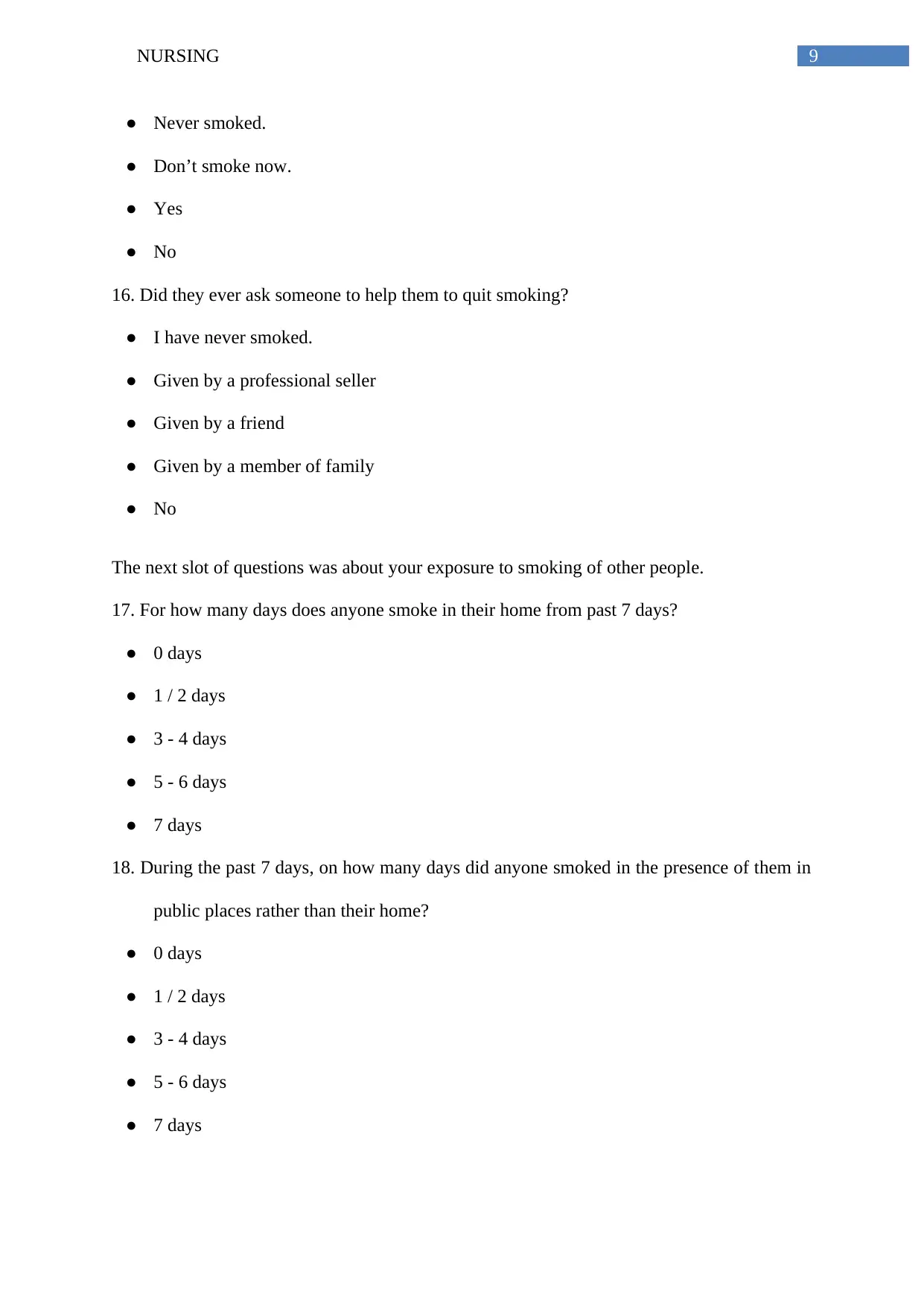
9NURSING
● Never smoked.
● Don’t smoke now.
● Yes
● No
16. Did they ever ask someone to help them to quit smoking?
● I have never smoked.
● Given by a professional seller
● Given by a friend
● Given by a member of family
● No
The next slot of questions was about your exposure to smoking of other people.
17. For how many days does anyone smoke in their home from past 7 days?
● 0 days
● 1 / 2 days
● 3 - 4 days
● 5 - 6 days
● 7 days
18. During the past 7 days, on how many days did anyone smoked in the presence of them in
public places rather than their home?
● 0 days
● 1 / 2 days
● 3 - 4 days
● 5 - 6 days
● 7 days
● Never smoked.
● Don’t smoke now.
● Yes
● No
16. Did they ever ask someone to help them to quit smoking?
● I have never smoked.
● Given by a professional seller
● Given by a friend
● Given by a member of family
● No
The next slot of questions was about your exposure to smoking of other people.
17. For how many days does anyone smoke in their home from past 7 days?
● 0 days
● 1 / 2 days
● 3 - 4 days
● 5 - 6 days
● 7 days
18. During the past 7 days, on how many days did anyone smoked in the presence of them in
public places rather than their home?
● 0 days
● 1 / 2 days
● 3 - 4 days
● 5 - 6 days
● 7 days
Paraphrase This Document
Need a fresh take? Get an instant paraphrase of this document with our AI Paraphraser
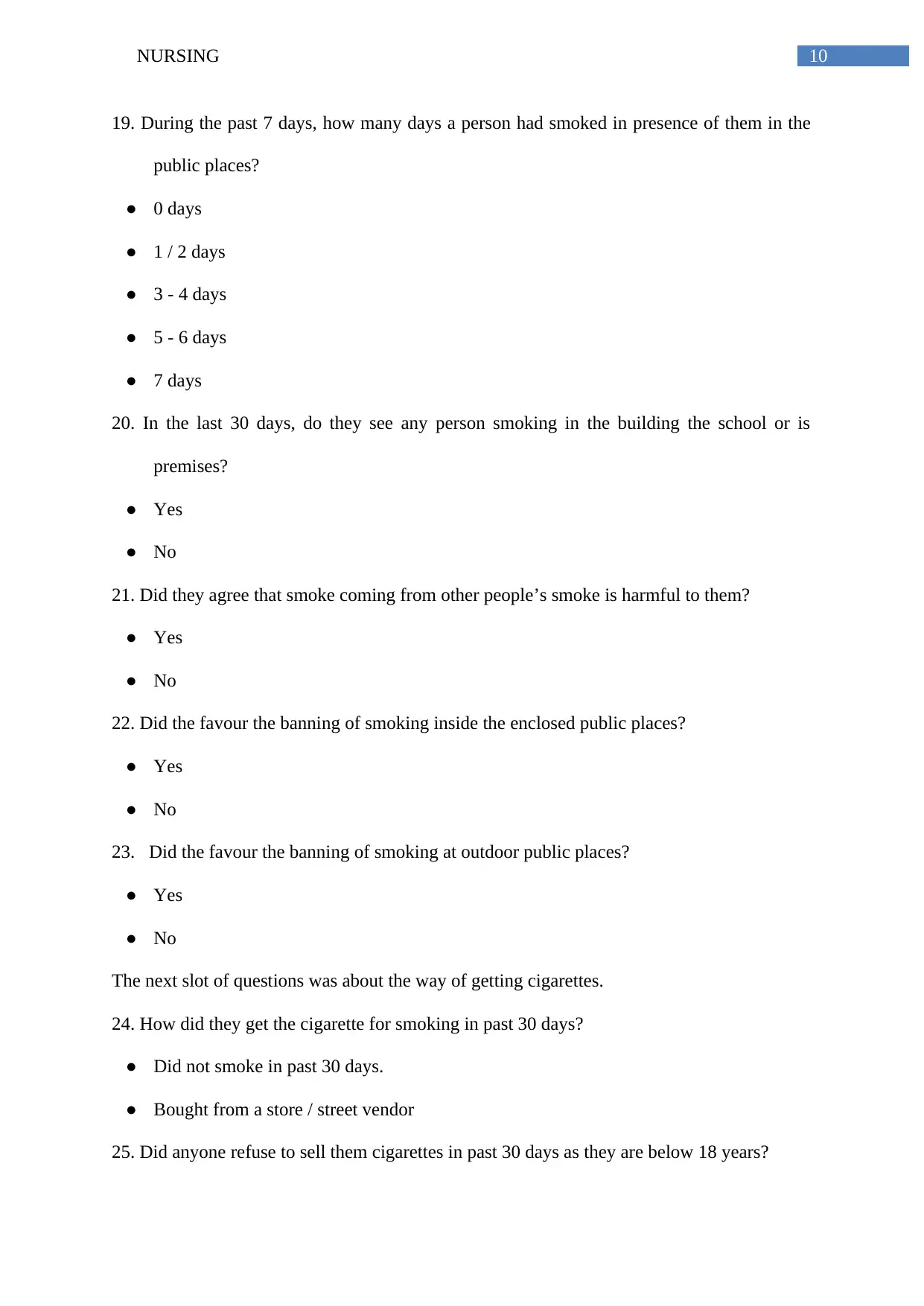
10NURSING
19. During the past 7 days, how many days a person had smoked in presence of them in the
public places?
● 0 days
● 1 / 2 days
● 3 - 4 days
● 5 - 6 days
● 7 days
20. In the last 30 days, do they see any person smoking in the building the school or is
premises?
● Yes
● No
21. Did they agree that smoke coming from other people’s smoke is harmful to them?
● Yes
● No
22. Did the favour the banning of smoking inside the enclosed public places?
● Yes
● No
23. Did the favour the banning of smoking at outdoor public places?
● Yes
● No
The next slot of questions was about the way of getting cigarettes.
24. How did they get the cigarette for smoking in past 30 days?
● Did not smoke in past 30 days.
● Bought from a store / street vendor
25. Did anyone refuse to sell them cigarettes in past 30 days as they are below 18 years?
19. During the past 7 days, how many days a person had smoked in presence of them in the
public places?
● 0 days
● 1 / 2 days
● 3 - 4 days
● 5 - 6 days
● 7 days
20. In the last 30 days, do they see any person smoking in the building the school or is
premises?
● Yes
● No
21. Did they agree that smoke coming from other people’s smoke is harmful to them?
● Yes
● No
22. Did the favour the banning of smoking inside the enclosed public places?
● Yes
● No
23. Did the favour the banning of smoking at outdoor public places?
● Yes
● No
The next slot of questions was about the way of getting cigarettes.
24. How did they get the cigarette for smoking in past 30 days?
● Did not smoke in past 30 days.
● Bought from a store / street vendor
25. Did anyone refuse to sell them cigarettes in past 30 days as they are below 18 years?
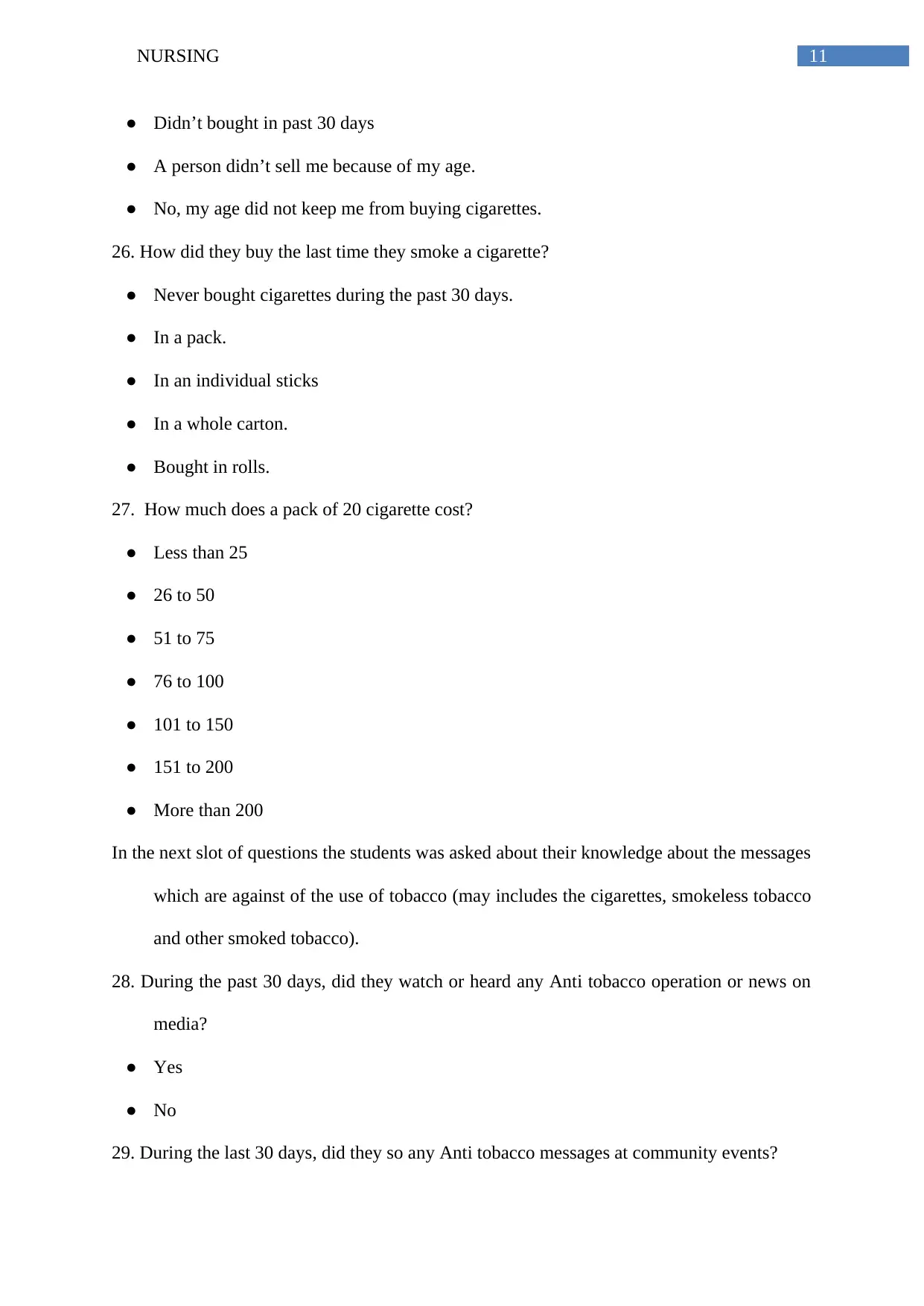
11NURSING
● Didn’t bought in past 30 days
● A person didn’t sell me because of my age.
● No, my age did not keep me from buying cigarettes.
26. How did they buy the last time they smoke a cigarette?
● Never bought cigarettes during the past 30 days.
● In a pack.
● In an individual sticks
● In a whole carton.
● Bought in rolls.
27. How much does a pack of 20 cigarette cost?
● Less than 25
● 26 to 50
● 51 to 75
● 76 to 100
● 101 to 150
● 151 to 200
● More than 200
In the next slot of questions the students was asked about their knowledge about the messages
which are against of the use of tobacco (may includes the cigarettes, smokeless tobacco
and other smoked tobacco).
28. During the past 30 days, did they watch or heard any Anti tobacco operation or news on
media?
● Yes
● No
29. During the last 30 days, did they so any Anti tobacco messages at community events?
● Didn’t bought in past 30 days
● A person didn’t sell me because of my age.
● No, my age did not keep me from buying cigarettes.
26. How did they buy the last time they smoke a cigarette?
● Never bought cigarettes during the past 30 days.
● In a pack.
● In an individual sticks
● In a whole carton.
● Bought in rolls.
27. How much does a pack of 20 cigarette cost?
● Less than 25
● 26 to 50
● 51 to 75
● 76 to 100
● 101 to 150
● 151 to 200
● More than 200
In the next slot of questions the students was asked about their knowledge about the messages
which are against of the use of tobacco (may includes the cigarettes, smokeless tobacco
and other smoked tobacco).
28. During the past 30 days, did they watch or heard any Anti tobacco operation or news on
media?
● Yes
● No
29. During the last 30 days, did they so any Anti tobacco messages at community events?
⊘ This is a preview!⊘
Do you want full access?
Subscribe today to unlock all pages.

Trusted by 1+ million students worldwide
1 out of 23
Related Documents
Your All-in-One AI-Powered Toolkit for Academic Success.
+13062052269
info@desklib.com
Available 24*7 on WhatsApp / Email
![[object Object]](/_next/static/media/star-bottom.7253800d.svg)
Unlock your academic potential
Copyright © 2020–2025 A2Z Services. All Rights Reserved. Developed and managed by ZUCOL.





